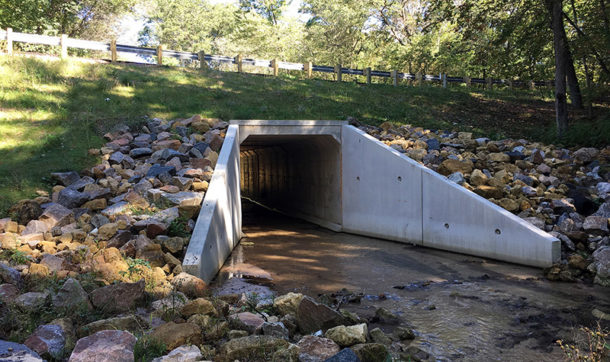Culverts: The Essential Infrastructure You Never Knew You Needed
The so-called “atmospheric rivers” that have dropped massive volumes of rain upon California this winter are calling renewed attention to the importance of adequate flood control infrastructure across the United States.

About the Expert:
Dan Sydow, PE, is Structural Engineering Group Manager of Ayres’ Midwest Transportation division. He has designed hundreds of bridge replacements and rehabilitations in nearly all Wisconsin counties and in 10 states, including project management of the 2018 Grand Avenue pedestrian bridge rehabilitation.
One important but often overlooked part of that infrastructure is the lowly culvert.
Culverts are everywhere. Indeed, for most of us, their ubiquity results in their practical invisibility. It’s only where they are not present, or they are present but failing, that we recognize the importance of these tunnel-like structures.
The basic role of the culvert is to safely channel water under or around some obstacle, most commonly a roadway or railway. But culverts also can be found serving other important roles, such as housing for electrical lines or other cables where they are stretched beneath or around various kinds of obstacles.
And in agricultural areas, particularly those with significant elevation changes, culverts often are installed to direct the flow of irrigation and rainwater in a manner that will help to minimize erosion and maximize crop health.
Load And Hydraulic Capacity Are Key Concerns
In the United States, federal agencies such as the Bureau of Land Management, the Federal Highway Administration, and the Environmental Protection Agency, as well as many state agencies, oversee the construction and ongoing maintenance of the millions of the nation’s culverts.
Most applicable federal and state standards focus on a culvert’s “load capacity,” meaning its ability to hold up under the weight of the traffic – be it automobiles, trains or something else — that will pass over it, and it’s “hydraulic capacity,” meaning its ability to handle the volume of water expected to pass through it.
These concerns address the culvert’s two primary functions: 1) to allow water to flow through without spilling onto the roadway or railway above; 2) to bear the weight of the traffic traveling over it without collapsing.
Culverts Come in a Variety of Materials, Shapes, Sizes
Because they are used for many different purposes and in many different settings, it’s no surprise that culverts are designed in a wide variety of ways. Most commonly they are constructed of concrete, steel, aluminum, or high-density polyethylene plastic. In some situations they may be made of some combination of these materials.
Perhaps the most commonly found type of culvert is a round pipe made of aluminum or steel. But other common shapes include pipe arches, box-shaped culverts, and bridge culverts.
In a majority of situations a single culvert will be suitable to fulfill the assigned task. But in projects requiring particularly high load or hydraulic capacities, multiple culverts may be combined into a single structure. This occurs often when culverts are made a part of major road, railway, or bridge projects. In such projects the culverts allow brooks, streams, or other waterways to safely pass beneath these transportation pathways.
Careful Planning Required
Because culverts usually are embedded in the ground, careful planning in their construction and ongoing maintenance is important. Of particular concern in their design is the prevention of soil erosion around the culvert. Also important is ensuring that debris and sediment passing through the culvert during extreme rainfalls or spring snowmelts does not create blockages that could limit the flow of water through the culvert. For these and other reasons, it’s important that the size, shape, and materials for the project be chosen carefully.
Environmental Concerns
A well-designed culvert also takes into consideration its potential impact on the environment in which it’s constructed. In addition to water quality concerns, the culvert also should avoid harm to wildlife common to the area it will serve.
The culvert should be designed and constructed in a manner that will allow fish and other aquatic life to swim through it easily, whether upstream or downstream. In some settings a culvert also will be sized to allow larger, non-aquatic animals common to the area to travel through it.
Indeed, some culverts built beneath roads and railways are large enough to allow animals as large as deer to safely cross beneath these potentially hazardous traffic venues. By providing safe passage for the animals, this provides the extra benefit of also enhancing traffic safety for the vehicles crossing over the culvert.
Give the Culvert Its Due
Though they often go unnoticed, culverts play an integral role nationwide in the ongoing efforts to direct the flow of water in ways that maximize the benefits of this essential resource while simultaneously helping to minimize its potential for causing catastrophe.
For more information regarding our structural design and inspection services, check out some of our recent projects or reach out to Ayres’ Dan Sydow.

 By
By
Post a comment: